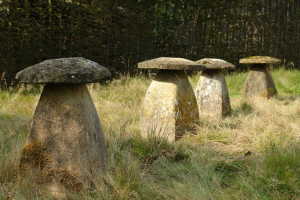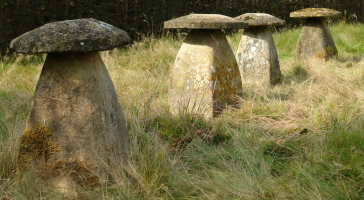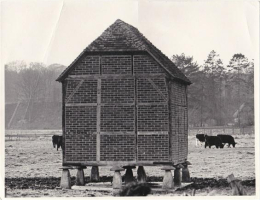- Home
- A set of 4 Ham stone staddle stones
A set of 4 Ham stone staddle stones
An impressive group of 4 staddle stones carved in Ham stone, late 18th- early 19th century. Ham stone is classed as being a “jurassic period warm limestone” and is solely extracted from Ham Hill in Somerset.
Dimensions: +/- 75 cm high
Condition: Very good condition
Reference: ARC092017
Literature:
Staddle stones (variations include Steddle stones) were originally used as supporting bases for granaries, hayricks, game larders, etc. The staddle stones lifted the granaries above the ground thereby protecting the stored grain from vermin and water seepage. In Middle English staddle or stadle is stathel, from Old English stathol, a foundation, support or trunk of a tree. They can be mainly found in England, Galicia and Asturias (Northern Spain).
The name itself and evidence from surviving vernacular buildings with wooden 'feet' suggest that at first the staddles or supports were made of wood, such as at Peper Harow granary in Surrey. Stone staddles were longer lasting and a more reliable means of supporting structures which were sometimes a considerable weight.
The name has become integrated into the landscape with bridges, houses, farms and other structures incorporating the name 'staddle'.
DESIGN
The staddle stones usually had a separate head and base which gave the whole structure a 'mushroom' like appearance. Different areas in the United Kingdom had different designs. The base varied from cylindrical to tapered rectangular to near triangular. Flat topped cone shaped staddle stones are to be found in parts of the Isle of Wight. The tops are flat to support the beams, however some variation does exists, such as square tops, fluted designs, slate tops, etc.
A fine example is the English Granary built 1731, Supported on Staddle Stones, which can be seen in the Weald and Downland Open Air Museum in West Sussex, UK. Such structures were common in Southern England in the 18th century. At Higher Farm in Heathfield, Tavistock, Staddle Stones are part of the substantial barns built by the Duke of Bedford in the 19th century. The dressed granite stone bases have specially hewn slate tops.
The materials used depended on the stone available, giving rise to sandstone, red sandstone, granite examples, etc.
The Museum of Scottish Country Life at Wester Kittochside near East Kilbride has two 'Stathels', made in Edinburgh of cast iron. The structure is basically a cast iron version of a set of staddle stones with its wooden framework. These rare survivals are still in use.
FUNCTION
The tops of the staddles were usually circular and this made it almost impossible for a rodent to climb up and into the hay or grain stored above. The air could freely circulate beneath the stored crops and this helped to keep it dry. A wood framework was placed onto the tops of the stones, the staddles being arranged in two or three rows, giving sixteen or more stones. The hayricks, Tithe barns, granaries, etc. were built on top of this frame.
GRANARIES AND BEEHIVES
These were often constructed with wooden weather-boards such as at Blaxland Farm in Sturry, Kent, which has nine staddles, however if the grain was stored loose then the sides were filled in with brick nogging and light lath-and-plaster at the wall tops. Wooden steps up to the buildings were detachable and stored by hanging them up on the side of the structure. If stone or brick steps were built then the top step was not built, thus denying access to rats and other vermin. Some of these granaries had a 'cat flap' and others had a recess inside the steps which served as a dog kennel.
Most granaries were used for the storage of two or three separate crops, having a capacity of 500 to 2500 bushels. The arrangement of the stones to support the structure and its weight when in use, required nine, twelve or sixteen staddles. The production of staddles was therefore a fairly significant local industry. Small granaries could make do with five, one being in the middle. The Upper Hexford granary in Oxfordshire uses thirty-six staddles.
Bee hives were often set on top of staddle stones to keep out predators and provide dry and airy conditions.
GAME LARDERS
Small staddle stones were used to support small roofed box-shaped larders which were used on the larger estates for storage of game, such as pheasant, brought back by shooting parties, etc.
BARNS
Timber-framed barns raised up on staddle stones were sometimes found in the south of England. Apart from the usual benefits it seems that some correlation between this barn type and the builder being a tenant exists. Being on staddles such barns remained the property of the tenant. In Galicia and Asturias (NW Spain), these barns are called hórreos.
Antieke Tuinornamenten
Viooltjesdreef 39031 Baarle-aan-de-Leie
info@antieke-tuinornamenten.be+32 (0) 9 282 20 97+32 (0) 475 53 41 63
Opening hours
Bezoek aan de tuin enkel na afspraak.



